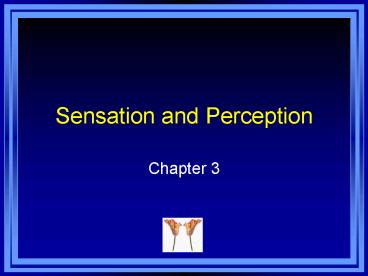Sensation and Perception - PowerPoint PPT Presentation
1 / 28
Title:
Sensation and Perception
Description:
Sensation and Perception. Chapter 3. Menu. LO 3.1 Sensation and the central ... 3. Vestibular senses - the sensations of movement, balance, and body position ... – PowerPoint PPT presentation
Number of Views:105
Avg rating:3.0/5.0
Title: Sensation and Perception
1
Sensation and Perception
- Chapter 3
2
LO 3.1 Sensation and the central nervous system
Menu
3
Habituation and Sensory Adaptation
LO 3.2 How sensations can be ignored
- Habituation - tendency of the brain to stop
attending to constant, unchanging information. - Sensory adaptation - tendency of sensory receptor
cells to become less responsive to a stimulus
that is unchanging. - Saccades - constant movement of the eyes, tiny
little vibrations called that people do not
notice consciously prevents sensory adaptation
to visual stimuli.
Menu
4
LO 3.4 Parts of the eye
Menu
5
LO 3.4 Parts of the eye
Menu
6
LO 3.5 How eyes see and how eyes see colors
Menu
7
LO 3.5 How eyes see and how eyes see colors
Menu
8
LO 3.5 How eyes see and how eyes see colors
Menu
9
LO 3.7 Parts of ear work together to hear sounds
Menu
10
LO 3.7 Parts of ear work together to hear sounds
Menu
11
Taste
LO 3.10 Senses of taste and smell
- Taste buds taste receptor cells in mouth
responsible for sense of taste - Gustation - the sensation of a taste.
- Five Basic Tastes
- Sweet
- Sour
- Salty
- Bitter
- Brothy
Menu
12
LO 3.10 Senses of taste and smell
Menu
13
LO 3.10 Senses of taste and smell
Menu
14
LO 3.11 Sense of touch and experiencing pain
Menu
15
Somesthetic Senses
LO 3.12 Senses that allow body to know it is
moving and balanced
- 2. Kinesthetic sense - sense of the location of
body parts in relation to the ground and each
other. - Proprioceptive receptors (proprioceptors)
- 3. Vestibular senses - the sensations of
movement, balance, and body position sensory
conflict theory an explanation of motion sickness
in which the information from the eyes conflicts
with the information from the vestibular senses,
resulting in dizziness, nausea, and other
physical discomforts.
Menu
16
LO 3.13 Perception and perceptual constancies
Menu
17
LO 3.13 Perception and perceptual constancies
Shape constancy
Menu
18
LO 3.14 Gestalt principles of perception
Menu
19
LO 3.14 Gestalt principles of perception
Menu
20
LO 3.14 Gestalt principles of perception
Do you see an old lady or a young lady?
Menu
21
LO 3.14 Gestalt principles of perception
Do you see a rabbit or a duck?
Menu
22
The white and black stripes on these zebras can
be reversed both can serve as either figure or
ground.
LO 3.14 Gestalt principles of perception
Menu
23
LO 3.14 Gestalt principles of perception
Menu
24
LO 3.16 Visual illusions
Menu
25
LO 3.16 Visual illusions
Menu
26
LO 3.16 Visual illusions
Ames room illusion
Menu
27
LO 3.17 Factors that influence perception
Menu
28
LO 3.17 Factors that influence perception
Menu































